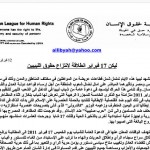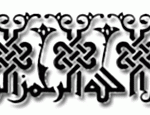وثائق بن لادن
Seventeen of the of the 6,000 documents seized from the compound of Osama bin Laden in May 2011 were released May 3, 2012. The documents – provided by the Combating Terrorism Center (CTC), and totalling 175 pages in the original Arabic and 197 pages in the English translation:
* Original Arabic (.zip) باللغة العربية
* English Translations (.zip) باللغة الانجليزية
نشرت يوم الخميس، 3 أيار/مايو، 17 وثيقة من أصل آلاف الوثائق التي عثر عليها في مجمع أسامة بن لادن في أيار/مايو 2011، بعد يوم على الذكرى الأولى لمقتل زعيم القاعدة
وتصف الوثائق التي نشرها مركز مكافحة الارهاب، ويبلغ عددها 175 صفحة باللغة العربية و197 صفحة مترجمة إلى الانجليزية، آليات عمل التنظيم الداخلية ومنها خلافات داخلية ونصائح للجماعات المرتبطة بالتنظيم ومخاوف لقادة بارزين فيه
The Combating Terrorism Center at West Point website has provided the following summary:
This report is a study of 17 de-classified documents captured during the Abbottabad raid and released to the Combating Terrorism Center (CTC). They consist of electronic letters or draft letters, totaling 175 pages in the original Arabic and 197 pages in the English translation. The earliest is dated September 2006 and the latest April 2011. These internal al-Qa`ida communications were authored by several leaders, most prominently Usama bin Ladin. In contrast to his public statements that focused on the injustice of those he believed to be the “enemies” of Muslims, namely corrupt “apostate” Muslim rulers and their Western “overseers,” the focus of Bin Ladin’s private letters is Muslims’ suffering at the hands of his jihadi “brothers”. He is at pain advising them to abort domestic attacks that cause Muslim civilian casualties and focus on the United States, “our desired goal.” Bin Ladin’s frustration with regional jihadi groups and his seeming inability to exercise control over their actions and public statements is the most compelling story to be told on the basis of the 17 de-classified documents. “Letters from Abbottabad” is an initial exploration and contextualization of 17 documents that will be the grist for future academic debate and discussion.
The 17 documents totaled nearly 200 pages in their English translation. The earliest one is dated 2006. The latest is from 2011, according to the center. Here are the 17 documents and summaries, which were based on a CTC document that accompanied the release of the bin Laden letters.
Summary: Bin Laden asks for a lengthy version of Anwar al-Awlaqi’s resume.
Summary: American Qaida spokesman Adam Gadahn writes on a media strategy for the anniversary of 9/11.
Summary: Bin Laden declines al-Shababa’s request for unity with al-Qaida.
Summary: This letter suggests that al-Qaida’s relationship with other terror groups was the subject of internal debate.
Summary: This letter is written by Mahmud al-Hasan (Atiyya) and criticizes the tactics of Pakistan’s Tehrik-e-Taliban Pakistan.
Summary: Jaysh al-Islam and Atiyya write back and forth on financial matters and legal advice.
Summary: This letter is part of another that was not released to CTC, but the author is concerned about al-Qaida’s image. The author was also concerned that because the name al-Qaida lacks religious overtones, the U.S. is able to wage war against the group without offending all Muslims.
Summary: Bin Laden lays out his views of the Arab Spring. The letter is dated a week before the raid that killed him.
Summary: This letter is addressed to a legal scholar who is alarmed with the conduct of al-Qaida in Iraq.
Summary: Atiyya wrote this letter addressed to the sheik, possibly bin Laden. The letter addresses the release of jihadi “brothers” from Iran.
Summary: The CTC summary says this document shows al-Qaida’s editing process: An unknown editor (possibly bin Laden) marks up statements form Ayman al-Zawahiri.
Summary: This document has two letters that, according to CTC, “read very much like an intelligence assessment, designed to provide Atiyya with some perspective on al-Qaida generally and the Islamic State of Iraq (ISI) more specifically.”
Summary: This letter focuses on issues in Afghanistan and Pakistan but also mentions the organization’s media plan for the 10th anniversary of 9/11.
Summary: The author of this letter, possibly bin Laden, Atiyya, or both of them, advises al-Qaida in the Arabian Peninsula to focus attacks on the U.S., not Yemen’s government.
Summary: This letter focuses on strategy and the need for the group to attack the United States.
Summary: This letter is critical of bin Laden and urges him to change al-Qaida’s policy. The author says that people are now repulsed by the term jihad.
Summary: This is a long letter written by bin Laden in which he discusses his concern over the mistakes that regional jihadi groups have made.
*****
RELATED:
Key Documents — Al Qaeda & Jihadi Movements Worldwide (volumes 1-50)
Reference Corporation’s on-going Al Qaeda & Jihadi Movements Worldwide (AQJM) reference series, in early 2011, in 50 volumes, has several built-in finding guides to assist researchers. One finding guide is the Key Documents list, a bibliography with extensive cross references and scope notes. However, Key Documents is a large document and cannot be reprinted in every new incremental set of AQJM reference books. For example, the Key Documents list in the cumulative index to the first twenty volumes of AQJM is over 120 pages long. AQJM for volumes 1-50 is 332 pages long.
To make Key Documents more useful, this downloadable Key Documents list is cumulative for all AQJM volumes and will always be current.
This Key Documents edition is a cumulative finding aid for AQJM volumes 1-50

















